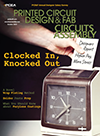Products
Debug Pro debugging software for TestStation in-circuit testers is said to feature intuitive graphical user interface, comprehensive tools, simplified command menus, and operational displays for debugging and qualifying ICT programs. Features include a label navigator that graphically displays each of the program’s tests; a statement editor that displays specified parameters available in user-selected tests and permits parameter selection and modification using a mouse or keystrokes; a guard editor that displays test instrument connections and in-circuit interconnections; a charting tool that displays measurement results using run or histogram charts and reports test statistics; component and property information windows that display information about board components, nets and other tester resources, and a customizable toolbar providing access to debug tools.
Teradyne, www.teradyne.com
Teradyne, www.teradyne.com
SL101 air-controlled dispenser is CE-certified and RoHS-compliant. Features three modes of operation (manual, timed and cycle) and 10 memory positions for dispensing control and flexibility. Available in 110V and 220V versions and is said to be suitable for use with a wide range of liquids. Equipped with suck-back control. Comes with accessory kit.
I&J Fisnar, www.ijfisnar.com
The PS588 high-volume offline programmer now features ICOS 3D inspection. Is said to combine programming and 3D inspection into one high-speed process. Robotic head picks and presents device to the ICOS inspection module, where x, y and z axes are visually inspected for flaws or damage. Post-programming inspection reportedly ensures all passed devices fall within the coplanarity tolerances before output to media. Also inspects lead pitch and slant. Designed for OEM/ODM or programming centers producing in high volumes for small or large batches.
Data I/OR, www.data-io.com
ICOS Vision Systems, www.icos.be
Data I/OR, www.data-io.com
ICOS Vision Systems, www.icos.be
Press Releases
- E-tronix Hosts Webinar with Laser Wire Solutions CEO on Advancing Medical Manufacturing Through Laser Technology
- Niche Electronics Completes Transition to Enhanced Leadership Team
- Aegis Software Expands its Presence in France and Partners with STPGroup
- Altus Adds Breakthrough Automated Inline Laser Depaneling System to its Line-Up


